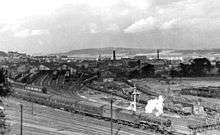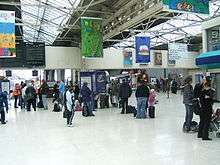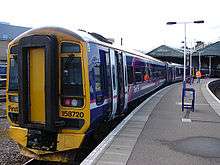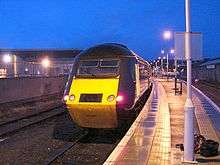Inverness railway station
| Inverness | |
|---|---|
| Scottish Gaelic: Inbhir Nis | |
|
Inverness railway station | |
| Location | |
| Place | Inverness |
| Local authority | Highland |
| Coordinates | 57°28′48″N 4°13′23″W / 57.4800°N 4.2230°WCoordinates: 57°28′48″N 4°13′23″W / 57.4800°N 4.2230°W |
| Grid reference | NH667454 |
| Operations | |
| Station code | INV |
| Managed by | Abellio ScotRail |
| Owned by | Network Rail |
| Number of platforms | 7 |
|
Live arrivals/departures, station information and onward connections from National Rail Enquiries | |
| Annual rail passenger usage* | |
| 2002/03 | 0.721 million |
| 2004/05 |
|
| 2005/06 |
|
| 2006/07 |
|
| 2007/08 |
|
| 2008/09 |
|
| 2009/10 |
|
| 2010/11 |
|
| 2011/12 |
|
| 2012/13 |
|
| 2013/14 |
|
| 2014/15 |
|
| – Interchange | 72,055 |
| History | |
| Original company | Inverness and Nairn Railway |
| Pre-grouping | Highland Railway |
| Post-grouping | LMS |
| 5 November 1855 | Opened |
| National Rail – UK railway stations | |
| * Annual estimated passenger usage based on sales of tickets in stated financial year(s) which end or originate at Inverness from Office of Rail and Road statistics. Methodology may vary year on year. | |
|
| |
Inverness railway station is the railway station serving the Scottish city of Inverness.
History

Opened on 5 November 1855[1] as the western terminus of the Inverness and Nairn Railway to designs by the architect, Joseph Mitchell.[2] The platform roofs were extended in 1876 by Murdoch Paterson. Between 1966 and 1968 under British Rail the station buildings were replaced, the new design by Thomas Munro and Company.
It is now the terminus of the Highland Main Line, the Aberdeen-Inverness Line (of which the Inverness and Nairn Railway is now a part), the Kyle of Lochalsh Line and the Far North Line.
Description

Inverness is owned by Network Rail. However, it is operated by Abellio ScotRail who run most of the services using the station. Caledonian Sleeper and Virgin Trains East Coast run the only non-ScotRail services.
The station itself sits at one apex of a triangular junction in the centre of Inverness, with each half of the station connected to one line. The Highland Main and Aberdeen Lines both approach the station from the east and use Platforms 1-4, while the Far North Line (which also carries traffic heading for the Kyle Line) approach from the north-west and use Platforms 5-7. Platform 5 also has a connection from the east side, but it is only usable by a two car train, and even then, it must not be in passenger service and movements from Platform 5 to the east line are not allowed.
A single parliamentary train is run along the third chord of the triangle each weekday, as part of a through Kyle-Elgin service, which runs across the chord before reversing into the station. In the 2013 timetable, this is currently the 1714 Kyle-Elgin service.
The third chord runs between Rose Street Junction on the Far North Line and Welsh's Bridge Junction on the Aberdeen/Perth line. The Aberdeen and Perth lines diverge at Millburn Junction a short distance beyond Welsh's Bridge. Signalling for the entire area is controlled from a panel box near the station built in 1988. This supervises the station area & approaches and also houses the Radio Electronic Token Block (RETB) control desk that monitors the full length of the Kyle & Far North lines. RETB was installed by British Rail.
Platform destination LED screens are installed, along with a main departures and arrivals information board. Each of Platforms 1-7 has its own screen showing departures from that platform. Screens are also present behind the wall for all platforms from 3-6. In addition, several other screens are also visible for general information.
Inverness approaches | ||||||||||||||||||||||||||||||||||||||||||||||||||||||||||||
|---|---|---|---|---|---|---|---|---|---|---|---|---|---|---|---|---|---|---|---|---|---|---|---|---|---|---|---|---|---|---|---|---|---|---|---|---|---|---|---|---|---|---|---|---|---|---|---|---|---|---|---|---|---|---|---|---|---|---|---|---|
Legend
| ||||||||||||||||||||||||||||||||||||||||||||||||||||||||||||
Services
Air
Stagecoach in Inverness route 11 runs every 30 minutes between Inverness city centre and Inverness Airport. The bus leaves from Strothers Lane, just around the corner from the station. Journey time to the airport is 25 minutes.
Bus
The main coach and bus station is located in Margaret Street, 150 m northwest of and just around the corner from the railway station. Many services can also be joined at the stop on Milburn Street outside Marks and Spencer, closer to the station.
Aside from local buses, there are also long-distance coach services which allow rail passengers to continue their journey to areas of the Highlands not on the rail network:
- Scottish Citylink route 961 operates two daily return services to Ullapool to connect with Caledonian MacBrayne ferry sailings to Stornoway on the Isle of Lewis. (Rail passengers may also connect with this bus at Garve on the Kyle of Lochalsh line, but the timings are not so convenient.)
- Scottish Citylink route 919 operates six daily return services down the Great Glen to Fort William, calling at Urquhart Castle, Fort Augustus and intermediate points. Two of these services allow onward connections with Citylink route 918 from Fort William to Oban.
Rail
Current services
As of May 2016:
- 7 trains per day to Edinburgh Waverley via Perth.[3]
- 4 trains per day to Glasgow Queen Street.
- 11 trains per day to Aberdeen - one of these continues to Edinburgh via Dundee. An additional evening service runs to Elgin (which operates through from the Kyle line).[4]
- 12 trains per day (13 on Fridays and Saturdays) via Dingwall, of which:
- 4 trains per day to Wick and Thurso.
- 4 trains per day to Kyle of Lochalsh.
- Other services terminate at Invergordon, Tain or Ardgay.[5]
- 1 train per day to London King's Cross via, Falkirk Grahamston, Edinburgh, Newcastle and York (the "Highland Chieftain").[6]
- 1 sleeper train per day to London Euston via Preston and Crewe (the Highland Caledonian Sleeper - doesn't operate on Saturday nights).[7]
Future Planned Improvements
From 2018, this station will be one of those to benefit from a package of timetable enhancements to be introduced by Transport Scotland and Scotrail. The current Perth to Inverness timetable will be increased to hourly each way, with trains south of there running on alternate hours to Edinburgh & Glasgow. Journey times will be reduced by 10 minutes to both cities. The service to Nairn, Forres & Elgin will also be enhanced to hourly and some Aberdeen trains extended through to Dundee and beyond.[8]
| Preceding station | |
Following station | ||
|---|---|---|---|---|
| Aviemore | Virgin Trains East Coast East Coast Main Line (Highland Chieftain) |
Terminus | ||
| Carrbridge | Abellio ScotRail Highland Line |
Terminus | ||
| Nairn | Abellio ScotRail Aberdeen to Inverness Line |
Terminus | ||
| Terminus | Abellio ScotRail Far North Line Kyle of Lochalsh Line |
Beauly | ||
| Aviemore | Caledonian Sleeper Highland Caledonian Sleeper |
Terminus | ||
| Historical railways | ||||
| Culloden Moor Line open; station closed |
Inverness and Aviemore Direct Railway | Terminus | ||
| Allanfearn Line open; station closed |
Inverness and Nairn Railway | Terminus | ||
| Terminus | Inverness and Ross-shire Railway | Clachnaharry Line open; station closed | ||
Previous service patterns
Summer 2008


| Destination | Mon-Fri | Sat | Sun |
|---|---|---|---|
| Aberdeen | 10 | 10 | 6 (2 additional services terminate at Elgin) |
| Dingwall | 11 | 11 | 2 |
| Edinburgh | 6 | 6 | 3 |
| Glasgow Queen Street | 3 | 3 | 2 |
| Kyle of Lochalsh | 3 | 3 | 1 |
| London Euston (Caledonian Sleeper) | 1 | - | 1 |
| London King's Cross (Highland Chieftain) | 1 | 1 | 1 |
| Wick/Thurso | 3 | 3 | 1 |
Winter 2008
| Destination | Mon-Fri | Sat | Sun |
|---|---|---|---|
| Aberdeen | 10 | 10 | 6 (2 additional services terminate at Elgin) |
| Dingwall | 11 | 11 | 6 |
| Edinburgh | 6 | 6 | 3 |
| Glasgow Queen Street | 3 | 3 | 2 |
| Kyle of Lochalsh | 4 | 4 | 1 |
| London Euston (Caledonian Sleeper) | 1 | - | 1 |
| London King's Cross (Highland Chieftain) | 1 | 1 | 1 |
| Wick/Thurso | 4 | 4 | 1 |
Summer 2009
| Destination | Mondays-Fridays | Saturdays | Sundays |
|---|---|---|---|
| Aberdeen | 11 (1 additional service terminates at Elgin) |
11 (1 additional service terminates at Elgin) |
5 |
| Dingwall | 13 | 13 | 7 |
| Edinburgh | 7 (Including Highland Chieftain and 1 service via Aberdeen ) |
7 (Including Highland Chieftain and 1 service via Aberdeen ) |
3 (Including Highland Chieftain ) |
| Glasgow Queen Street | 3 | 3 | 2 |
| Kyle of Lochalsh | 4 | 4 | 2 |
| London Euston (Caledonian Sleeper) |
1 | nil | 1 |
| London King's Cross (Highland Chieftain) |
1 | 1 | 1 |
| Wick/Thurso | 4 | 4 | 2 |
References
- ↑ Butt (1995)
- ↑ The Buildings of Scotland, Highland and Islands. John Gifford. Yale University Press. 1992. ISBN 0-300-09625-9
- ↑ GB eNRT May 2016 Edition, Table 229
- ↑ GB eNRT May 2016 Edition, Table 240
- ↑ GB eNRT May 2016 Edition, Table 239
- ↑ GB eNRT May 2016 Edition, Table 26
- ↑ GB eNRT May 2016 Edition, Table 403
- ↑ "‘Rail revolution’ means 200 more services and 20,000 more seats for Scots passengers"Transport Scotland press release 15 March 2016; Retrieved 18 August 2016
Sources
- Butt, R. V. J. (1995). The Directory of Railway Stations: details every public and private passenger station, halt, platform and stopping place, past and present (1st ed.). Sparkford: Patrick Stephens Ltd. ISBN 1-8526-0508-1. OCLC 60251199.
- Jowett, Alan (March 1989). Jowett's Railway Atlas of Great Britain and Ireland: From Pre-Grouping to the Present Day (1st ed.). Sparkford: Patrick Stephens Ltd. ISBN 1-8526-0086-1. OCLC 22311137.
- Jowett, Alan (2000). Jowett's Nationalised Railway Atlas (1st ed.). Penryn, Cornwall: Atlantic Transport Publishers. ISBN 0-9068-9999-0. OCLC 228266687.
External links
| Wikimedia Commons has media related to Inverness railway station. |
